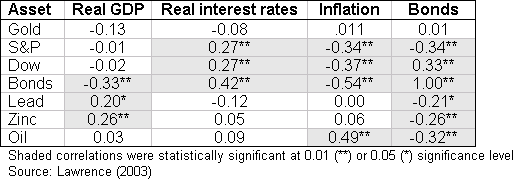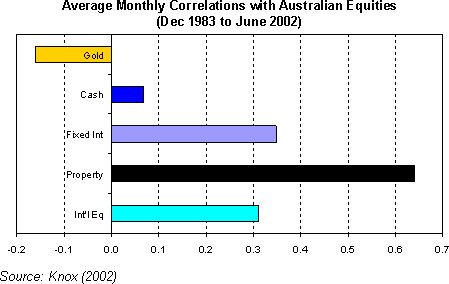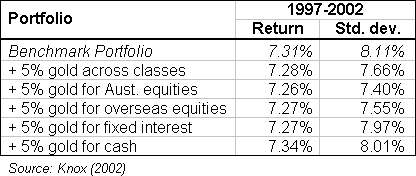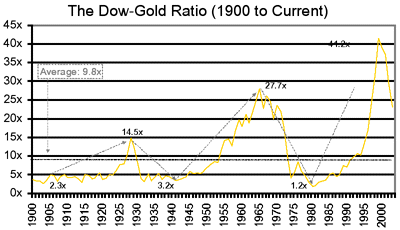A new tool for portfolio risk management - gold bullion
April 2003
April 2003
Nik Bienkowski CFA
Head of Institutional Investment, Gold Bullion Limited
Head of Institutional Investment, Gold Bullion Limited
2. Why invest in gold bullion
It is accepted practice in the finance industry that assets with low or negative correlation can decrease portfolio risk and expand the efficient frontier (see Markowitz). One of the main benefits from investing in gold bullion is that it is either negatively correlated or independent from other asset classes (Harmston (1998), Smith (2001, 2002), Knox (2002)) or financial and macro-economic measures (Lawrence (2003), Knox (2002)). Many alternative assets exist, perhaps with low correlation to the major asset classes, however, in contrast gold bullion is highly liquid, fungible, easily stored and requires little to no management.
2.1 Low-to-negative Correlation
International Research
The body of research studying the statistical benefits of holding gold bullion in a portfolio is slowly growing. The corner-stone piece of this research was written in 1977 by Roy Jastram "The Golden Constant - The English and American Experience 1560-1976". Jastram's book investigated the price and purchasing power of gold over time and during different periods, for example, inflationary and deflationary times. He concluded that gold bullion has held its purchasing power parity with other commodities and intermediate products over the very long term. In this study, the use of commodities as a basis of comparison enabled construction of a long-dated index which represented a CPI-style index (CPI did not exist 400 years ago).
In 1998, Harmston, updated Jastram's seminal research, while also looking at the relationship between gold bullion and other asset classes. Harmston's study covered the US (from 1796), Britain (from 1596), France (from 1820), Germany (from 1873) and Japan (from 1880). Harmston ran a series of regressions and showed that there was a positive relationship between the annual movements in bonds and T-bills with the annual movements in the Dow Jones Average Index (DJI) for the period 1968 to 1996. Over the same period, Harmston found that gold bullion had a negative relationship with the DJI.
As a result of the Jastram and Harmston studies becoming widely publicised, new research is gradually becoming available which supports the argument that gold is not related or negatively correlated with common portfolio constituents. Until 2002, this research had focussed on the US (Smith (2001), Lawrence (2003)) and Europe and Japan (Smith (2002)). Although gold bullion is traded globally, it is priced in U.S.-dollars, however it is likely that non-U.S. investors will track the returns from gold bullion in their home currency. The Jastram and Smith studies show that gold bullion has negative or no correlation with domestic equities in other major currencies. The following examples using monthly closing prices support this conclusion:

More recently, Colin Lawrence (2003) concluded that gold bullion was not only negatively or insignificantly correlated with equities, but that is was not related to macroeconomic variables such as GDP, inflation and interest rates. Using dynamic (Vector Auto Regression) and static (correlation) approaches, gold was found to be one of two assets which was not related to any of the macroeconomic or financial measures tested. The other mainstream financial assets, as expected, were positively related to economic activity (see table below). Recent Australian-based research (Knox (2002)) also concluded that gold bullion was not significantly related to GDP, CPI, Australian equities and overseas equities.

Australian Research
While the international research shows that gold bullion is negatively or not related to the major asset classes, one might expect that this relationship could be different when examined in the Australian context. This is because the Australian-dollar often moves in the same direction to the U.S.-dollar gold price (so when the U.S.-dollar gold price goes down, often the Australian-dollar gold price goes up). Dr David Knox and PricewaterhouseCoopers Actuarial (2002) investigated the relationship of Australian-dollar-denominated gold bullion ("A$Gold") with the major asset classes used by Australian Superannuation funds between 1983 and 2002. The period which Knox chose for his report dates back to the year in which the Australian-dollar was floated. The report concluded that A$Gold had negative or no correlation with Australian equities, as illustrated in the following chart:

Since it is accepted that assets with negative correlation can increase the efficient frontier (i.e. increase return for little/no change in risk), Knox then examined the trade-off between risk and return resulting from the inclusion of A$Gold in a "Benchmark" Australian portfolio. Knox's Benchmark portfolio was based on the Australian Prudential Regulation Authority's (APRA) data of Total Superannuation Assets: 46% Aus Equities, 20% Int'l Equities, 20% Fixed Interest, 6% Property and 8% Cash. The table below shows the results of introducing a 5% allocation to gold bullion across different asset classes for the five-year period to June 2002:

The results from this table support Knox's finding that an exposure to gold over the period 1997 to 2002 would have placed a portfolio with some gold on the efficient frontier. For the previous five year period, a decrease in risk could have been achieved with a slight reduction in return.
2.2 Gold outperforms in "stress" periods
The studies discussed above analysed the behaviour of gold over long and random periods and support that an allocation to gold could have a positive effect on a portfolio's risk-return outcomes. Knox (2002) showed that for an Australian portfolio, an allocation to gold can reduce the probability of an extreme outcome. It is this "insurance" against extreme movements in traditional asset values which makes gold useful to have in a portfolio during periods of market turbulence.
Chow, Jacquier, Kritzman and Lowry (1999) investigated the relationship between movements in the major asset classes and commodities during "stressful" and "non-stressful" periods. Chow et al show that the correlation between the major asset classes becomes more positive during "stressful" periods while the correlation of commodities with the major asset classes becomes more negative (see table below). Chow et al define a "stressful" period where 25% of the observations fall outside a pre-specified range. It is not in the scope of this article to discuss this pre-specified range because their results are observed in 8-dimensional space (8 asset classes are examined simultaneously)!

The Chow et al study differentiates between the effect of these stressed and normal periods on the different asset classes because risk parameters are unstable (i.e. they constantly change). As a result, optimal portfolios based purely on static risk parameters or a "plain-vanilla", long-term focus, may not be able to withstand certain short-term extreme periods. Put simply, a portfolio designed for the long-term may not survive to generate long term performance unless it can withstand all market conditions. It is during these extreme or negative market conditions where portfolio managers are scrutinised more carefully by regulators and investors. For example, a fund which underperforms its peers by 1% or 2% during the "good" years, when it is still returning 10% or 15% per annum, will not be scrutinised in the same manner in which an underperforming fund is scrutinised during the bad years when its peer group is returning -5% per annum. Alternatively, a portfolio manager does not want to fall into the bottom quartile of funds simply because their fund could not withstand extreme markets. This can have a cannibalisation effect on the fund as not only is the fund underperforming, but an increase in redemptions will affect the viability of the fund's existence.
3. Gold is an alternative asset class
During these extreme times, when expected returns are low, capital preservation becomes the main priority rather than capital appreciation. As a result, portfolio investors will often seek alternative asset classes to stabilise and enhance portfolio performance. Knox (2002) makes the following comments which suggest that gold bullion is also classed as an alternative (or "different") asset class: it has a low or negative correlation with all the major asset classes; it pays no income; has experienced a low rate of return yet has a higher volatility than either cash or fixed interest; and is subject to different forces of supply and demand than those which affect other asset classes.
The following table, taken from UBS Pension Fund Indicators (2002), categorises precious metals (and thus gold) in the alternative asset class. The table compares the major alternative assets on a number of key investment criteria:

4. Strategic asset allocation
Asset allocation is not all theory - Australian investors held an allocation to gold in the past decade by simply holding a na飗e or Benchmark portfolio. This exposure to gold was obtained through gold equities listed on the Australian Stock Exchange (ASX). Today, Australian-domiciled gold equities make up less than 1% of the ASX and therefore about 0.5% of a benchmark portfolio (assuming a 50% equity allocation). Although gold is one of the oldest asset classes to exist, if not the oldest, it is not unreasonable that gold has "fallen" out of the benchmark portfolio. During the last twenty years, equities and other asset classes have experienced a bull-market while gold has underperformed. Despite gold's recent underperformance, the chart below shows that both equities and gold go through extended periods (ten to fifteen years) where one outperforms relative to other. As a result, an asset should not be discarded just because it has been out of favour for a while.

The Dow-Gold Ratio is the Dow Jones Industrial Average Index divided by the U.S.-dollar gold price
Since it is difficult to predict (1) when gold will outperform equities and (2) when portfolio returns will experience extreme volatility, the case exists that gold bullion could form part of a benchmark portfolio. Both Knox (2002) and Chow et al (1999) examined different allocation ranges for gold commodities in a benchmark/optimal portfolio. Knox (2002) concluded that between 2.5% and 7.5% allocation to gold placed the benchmark portfolio on the efficient frontier and Chow et al (1999) concluded that a range of 3% to 12% was an optimal allocation to commodities (based on their results in the United States). Combined, these results suggest that an Australian portfolio could benefit from an allocation to gold of about 5%. The specific allocation will obviously depend on each investor's objectives and their view of the market and relative returns.
5. Conclusion
In a time where there is increasing concern regarding capital preservation, assets which are negatively correlated to the major asset classes and independent of macroeconomic measures should be seen as key portfolio constituents. Gold bullion has been shown to hold these properties. In addition, gold bullion has preferred characteristics over other alternative assets which are becoming increasingly used as tools for risk management and differentiation in a low-return world. Gold bullion is liquid, low risk and easy to manage. The above results suggest that gold is a tool which can be used to manage portfolio risk.
Sources of data and information:
All of the articles mentioned above can either be found at Gold Bullion's website at www.goldbullion.com.au or from the author. Please contact nb@goldbullion.com.au
About Gold Bullion Limited:
Gold Bullion Limited recently listed on the Australian Stock Exchange under the symbol "GOLD". Gold Bullion Limited is an open-ended exchange traded fund - a world first for a single commodity to be traded on a securities exchange. The fund invests 100% of proceeds in allocated gold bullion which is kept on trust by HSBC Bank USA in London. For more information, please see our website.
References
Chow G., Jacquier E., Kritzman M., and K. Lowry (1999) "Optimal Portfolios in Good Times and Bad Times" Financial Analysts Journal, vol. 55, no.3, (March/June): 65-73.
Harmston S. (1998) "Gold as a Store of Value" World Gold Council, Research Study no.22
Jastram R. (1977) "The Golden Constant: The English an American Experience 1560-1976" John Wiley & Sons, New York
Knox D. (2002) "Gold Bullion and Superannuation Policies: A Review and Analysis of the Role that Gold Bullion Could Play in the Investment Policy of Australian Superannuation Funds", PricewaterhouseCoopers Actuarial
Lawrence C. (2003) "Why is Gold Different from Other Assets? An Empirical Investigation" World Gold Council
Smith G. (2001) "The Price of Gold and Stock Price Indices for the United States"
Smith G. (2002) "London Gold Prices and Stock Price Indices in Europe and Japan"
No comments:
Post a Comment